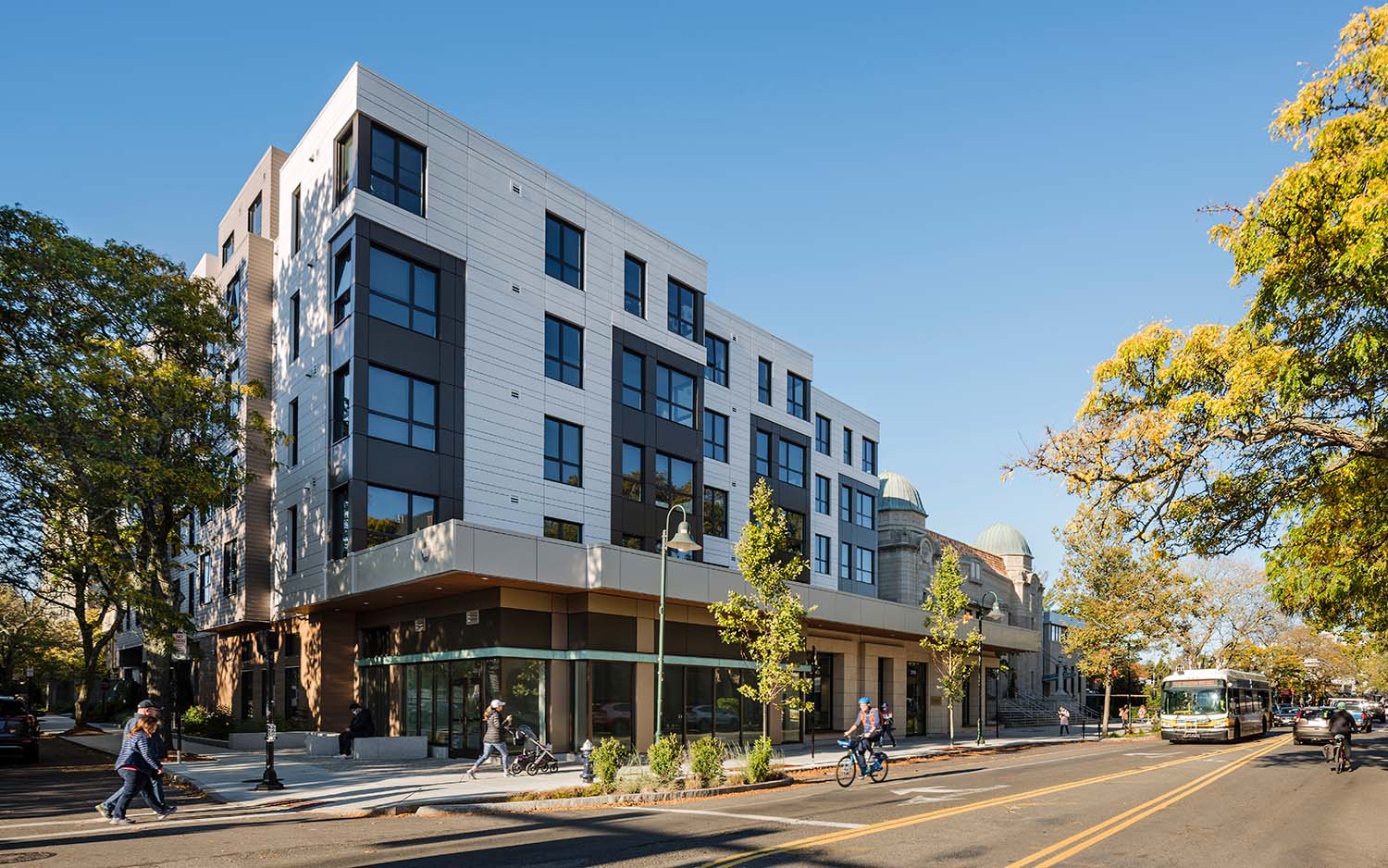Professor in Residence, Department of Architecture, GSD, Harvard University, Cambridge MA, USA
In 2006, Michael Stone, Chester Hartman and I published a co-edited book on the subject of this special issue: A Right to Housing: Foundation for a New Social Agenda (2006).1 We started our introductory chapter with this statement of outrage: “It is unconscionable that in the twenty-first century, upwards of one hundred million people in the United States live in housing that is physically inadequate, in unsafe neighborhoods, overcrowded or way beyond what they realistically can afford.” We noted the ethical basis of our argument, which invoked principles of justice and the ideal of a commonwealth. But we also pointed out the foundational role that housing plays in the lives of people – why a right to housing is needed and makes sense.
At the most basic level, decent quality housing provides shelter from the elements and the ability to live safely. The neighborhood one lives in has an impact on how secure one feels in their living environment, while also providing differential access to educational, job, and cultural opportunities. Housing and neighborhood quality also can be a symbol of the relative success in life of an individual, with accompanying psychological implications about their self-worth. The affordability of housing – whether the cost of shelter is low enough to enable the household to pay for other necessities – is another essential component of the housing bundle. If a household is paying too much of their income for housing, it can create untenable choices about the simultaneous need to cover the costs of food, medicine, and transportation to get to work. Another important aspect of housing is that owner-occupied units provide an opportunity for asset accumulation; the ability of homeownership to significantly boost the financial resources of a family has been cited as a key component of wealth inequality particularly among white people and people of color.2
A COMPELLING IDEA
But, in truth, my co-editors and I were late to the conversation. Nearly sixty years earlier, in 1948, the United Nations Universal Declaration of Human Rights stated: “Everyone has the right to a standard of living adequate for the health and well-being of himself and of his family, including food, clothing, housing and medical care…” Delegates to the UN also debated whether housing and other social and economic rights should be combined with civil and political rights. Although the General Assembly, in 1950, affirmed that all types of rights were interdependent, the UN Commission on Human Rights split the Universal Declaration into two separate covenants – one dealing with civil and political rights and the other addressing economic, social, and cultural rights. While the US ratified the first covenant, it is among a minority of nations that still has not ratified the second,3 which attempted to make these rights binding commitments within the limitations of the available resources of a country.4
In the United States, the concept of “the right of every family to a decent home” had been articulated by President Franklin Delano Roosevelt four years before the UN Declaration, as part of his Second Bill of Rights (1944).5 Inspired by this speech, one year later, the City of Los Angeles published a report titled “A Decent Home: An American Right.” 6 More recently, several cities and states have enacted right to housing/shelter statutes, notably Illinois and Massachusetts.7 Nevertheless, this right has never been adopted as federal policy. While the United States Housing Act of 1949 articulated a similar housing goal (“a decent home and a suitable living environment for every American family”), it did not declare a “right to housing.” In fact, in a 1972 US Supreme Court ruling (Lindsey v. Normet), the court declared the opposite – that citizens do not have a constitutional right to housing; instead, the responsibility to meet housing needs resides with state legislatures.8 Nevertheless, almost three decades after this ruling, and for the first time in seventy-seven years, a sitting US president advocated a right to housing.9 In January 2021, the American Rescue Plan under the President Joseph Biden administration announced that the funding would move towards “making housing a right for all Americans.” 10
Beyond the 175 countries that have ratified the International Covenant on Economic, Social and Cultural Rights,11 several other countries have explicitly embraced a right to housing. But, often, it is not clear what, exactly, this means. A Canadian advocacy group noted that their right to housing law, discussed below, was consistent with international human rights law, and “does not mean that the government must provide everyone with housing. [Instead, it] recognizes that all people have the ‘right to live somewhere in security, peace and dignity’ and that governments must implement reasonable policies and programs to promote this goal, given available resources.” 12 Indeed, countries that have legally adopted a right to housing are grappling with the extent of their liability if an unhoused person makes a claim against the government. Knowledge about the outcomes of the various right to housing statutes is limited since there is little research assessing these initiatives.
South Africa recognized the right to adequate housing in 1996. In the landmark Grootboom case, the Constitutional Court found that the state must both “devise and implement a coherent, coordinated housing program” as well as provide such a “program for those in most desperate need.” 13 This led to a new program, enacted in 2003, the Housing Assistance in Emergency Situations Act, which was focused on providing emergency housing and upgrading informal settlements. Yet, as one South African scholar put it, the “Promise of right to housing remains elusive in democratic South Africa.” 14 Grootboom underscored the difficulty of the issue: “The question is therefore not whether socio-economic rights are justiciable 15 under our Constitution, but how to enforce them in a given case.” 16
Since 1977, in Scotland, and elsewhere in the UK, there has been a right to permanent housing for certain priority groups (e.g., families with dependent children and vulnerable adults).17 Some right to housing legislation has been aimed at alleviating homelessness which, of course, is the most glaring type of acute housing distress. However, as of 2019, “Existing domestic legislation [fell] short of covering the right to adequate housing for everyone, and legal rights are essential to enable the achievement of adequate housing for many people… There is a real difference between what is agreed in Parliament as law, and what is experienced by someone in crisis.” 18 In 2020, legislation included the right to permanent housing for all unintentionally homeless people, not just specific subgroups.19
In France the concept of a “right to housing” was first articulated in 1982. Seven years later, it was declared a “fundamental right” and in 1995, the Constitutional Council defined “the possibility for everyone to have decent housing as an objective of constitutional value…” 20 Following the lead of Scotland, in 2007, with the enactment of France’s so-called DALO law, the right to housing became “justiciable.”
Although the DALO law was seen as “a step towards making the right to housing a reality,” 21 it has not yet fulfilled its promise. In 2019 the report of a UN Special Rapporteur (Leilani Farha) noted that: “While DALO has been successful in those regions where there is sufficient supply of adequate social housing, its implementation in bigger cities and metropolitan regions … gives rise for concern.” The UN report underscored the need for social housing to be available to all eligible persons within six months and called for increased social housing production. It also made clear that “The payment of fines must not replace the effective implementation of the right to housing.” 22
Canada is the most recent country to articulate a legal right to housing. Enacted in 2019, the National Housing Strategy Act states that their housing policy recognizes that “the right to adequate housing is a fundamental human right affirmed in international law…” 23 The new act calls for the creation of a National Housing Council and the appointment of a Federal Housing Advocate, who is responsible for monitoring the implementation of the housing program. Yet, as noted above, this may not guarantee a home for someone in need.
In 1978, the Spanish Constitution was adopted and stated: “All Spaniards have the right to enjoy decent and adequate housing” and directed public authorities “to make this right effective...” 24 However, the right is a “guiding principle” and does not “receive the strong jurisdictional protection enshrined in the Constitution for ‘fundamental rights’.” 25 When regional laws have tried to develop the right to housing, these initiatives have been challenged in the Central Constitutional Court of the government and almost all have been suspended. Lacking “powerful tools … to adequately protect the right to housing,” 26 various legal avenues have been pursued. In 2017, the UN Committee on Economic, Social and Cultural Rights responded to a case from Spain by, in part, offering a reminder that: “The right to housing should be ensured to all persons irrespective of income or access to economic resources, and States parties should take whatever measures are necessary to achieve the full realization of this right to the maximum of their available resources.” 27
Thus, even in those countries that have enacted right to housing statutes, the lack of effective implementation is the norm. Whether or not a country formally adopts a right to housing, or has, instead, opted for language that embraces similar-sounding goals, I am not aware of any country that has been able to provide decent and affordable housing for its entire population. Why is that?
AN ELUSIVE REALITY
A lack of sufficient resources may be the simplest reason why the right to housing has not been achieved. In many countries around the world, the financial capacity for the state to assume the cost of producing and maintaining housing to meet the needs of its entire population may be virtually impossible. Whether or not a country is resource-rich, the answer to why a right to housing has not been realized is due to several intertwined constraints and challenges: the treatment of housing as a commodity; land use regulations; the relationship between housing costs and income; inadequate production and availability of social housing; and political debates and conflicting views about how available resources should be used.
Much of my co-edited book, A Right to Housing, focuses on the working of the housing market with housing being viewed as a commodity. Most housing around the world is bought, sold, and operated for profit. Each step along the way of the housing production and maintenance processes, as well as the many activities involved in sales, requires a host of private sector actors – each of whom is committed to maximizing the profitability of the specific task in which he/she is engaged. The net result is that housing costs climb, as each step adds costs of materials, labor, and profit margins.
The cost of producing housing is also due to factors associated with land availability and land use regulations. The decreasing availability of buildable land (whether because locations are built-out or subject to environmental constraints), combined with construction materials being in short supply in the COVID era, has resulted in escalating housing costs. In addition, various land use and zoning regulations constrain how much and what type of housing can be built on a particular parcel, thereby raising land prices and creating artificial limitations on the ability to build high density or multifamily units.
High housing costs, alone, would not be problematic if incomes were keeping pace with those costs. But they are not. Thus, another key factor thwarting the ability of nations to meet the housing needs of their population is the widening gap between wages and housing costs. The title of a recent article in The New York Times captured the problem: “Wages Can’t Keep Up with Spike in Housing Prices,” (May 5, 2022). And, further: “soaring housing prices are outpacing wage growth in cities around the world, putting the squeeze on countless would-be homeowners.” 28 In twenty-one of the thirty-three member countries of the Organization for Economic Co-operation and Development (OECD) for which data are available, house prices have risen faster than incomes.29
In the US, the National Low Income Housing Coalition tracks the disparity between income and housing costs. A recent report states: “In no state, metropolitan area, or county in the US can a worker earning the federal or prevailing state or local minimum wage afford a modest two-bedroom rental home at fair market rent by working a standard forty hours a week.” 30
A critical part of the problem is that there are only thirty-six affordable and available rental homes for every one hundred extremely low-income renter households. The overall need for extremely low-income households (those with incomes are at or below the poverty guideline or 30 % of their area median income) is staggering: a shortage of seven million units.31
The key way that housing can remain affordable over the long-term is if it is part of the social housing stock. These rental units are either owned by public entities or nonprofit organizations and have subsidized rents; homeownership units typically have deed restrictions that limit the resale value of a home. None of the thirty-one countries for which such information is readily available has a housing stock that is comprised primarily of social housing. At the high end, The Netherlands, has slightly more than 35 % of its stock classified as social housing, followed by Denmark, Austria, and the United Kingdom with social housing comprising about 20 % of the housing stock of each country. Less than 5 % of the housing stock in the United States is considered social housing.32 My rough estimate is that there are about one and a half million public housing units (including about 300,000 units of military housing owned by the US Department of Defense, rather than state or local public housing authorities) and about three and a half million nonprofit-owned units for a total of just over five million social housing units (out of more than 140 million total housing units).33
Based on analyses of data on home sale prices and household income in the United States, a rule of thumb suggests that the price of a home should be no more than 2.6 times the amount of the annual income of a household.34 This relationship stayed relatively constant between 1950 and 2000, but in 2010, median home values jumped to more than four times median household income.35 One independent analysis of real estate data announced that: the “portion of wages required for homeownership grows at fastest pace in more than fifteen years; historic affordability down in almost 80 % of markets.” 36
Finally, to the extent that any given country has at least some resources that could be used to produce new affordable housing or subsidize existing units to make them available and affordable to lower income groups, there is always the question of whether the government is so inclined to spend money in this way. I, along with many other housing analysts and practitioners have, for years, been saying that the problem is not a lack of information about how to build and maintain good quality affordable housing. In 2012, I ended an article with this brief statement: “The mechanisms needed to support producers of social housing are well understood. We are not confronted by a lack of knowledge about how to solve our housing problems; the limiting factor is our collective political will.” 37 And, a recent book by two highly respected and experienced housing experts states: “We know how to do it. We know how to provide people with effective housing assistance…Evidence supports housing programs’ successes, but what is needed to drive a systematic end to homelessness…is political will.” 38
As housing continues to be a major focus in countries across the world, we need to keep in mind not only the forces at play that thwart the realization of a right to housing, but also the kinds of initiatives that are steps toward that goal. These include:
(1) Providing funding for the development and preservation of high-quality affordable housing,
(2) Prioritizing nonprofit–owned, long-term affordable housing and promoting a “nonprofit-centric housing system.” 39 This would include providing subsidies to bring projects to fruition and promoting efficient management; making units affordable to the lowest income households; and facilitating the provision of resident services programs,
(3) Forming partnerships with potential public and private development entities,
(4) Using affordable housing as a mechanism to incorporate state-of the-art and innovative environmental materials and designs,
(5) Educating ourselves and others about the importance of a right to housing and articulating the connections between health and overall well-being and the role of housing in reducing wealth inequality,
(6) Ensuring that anti-discrimination statutes are in place and strictly enforced,
(7) Exploring mechanisms to help households facing foreclosure retain their homes and cover rent payments for tenants,
(8) Assessing state and local housing markets and developing targeted strategies. Strong markets could support inclusionary zoning, linkage and transfer taxes, housing trust funds and mechanisms to provide dedicated sources of revenue for affordable housing,
(9) Encouraging state and local governments to make sure that land use patterns are not arbitrarily restrictive and that they promote diverse types of housing,
(10) Identifying state and local public and private vacant land and buildings for possible affordable housing opportunities by, for example, working with local religious groups that may have excess land and promoting accessory dwelling units, and
(11) Requesting the federal government to promote the disposition of excess land and buildings for affordable housing.
As my generation of housing analysts, advocates, academics, and practitioners leaves the policy arena, we yield the debate to those who are similarly captured by the compelling need and logic for a right to housing. I hope the contributions in this special issue will help keep the idea alive and that the authors and their colleagues will help make the provision of safe, secure, and affordable housing a universal reality.
Brown Family House is an example of US social housing located in Brookline, Massachusetts. 2Life Communities, a nonprofit housing organization, developed the property and owns it. The structure, designed by Prellwitz Chilinski Associates, was completed in 2020. Brown Family House is comprised of sixty-two rental units for adults sixty-five years old and above. Major funding for the project came from the federal Low-Income Housing Tax Credit program. Additional funding came from about one dozen other state, local and philanthropic sources. About 80 % of the units are rented to persons at 60 % (or less) of Area Median Income (AMI); eight units are rented to persons with incomes of up to 110 % of AMI; and three are unrestricted. Affordability of the units is guaranteed for seventy-five years.
Michael Stone and Chester Hartman had a longstanding interest in a right to housing. In 1989, they, along with other colleagues, drafted “The Right to Housing: A Blueprint for Housing the Nation” (Oakland, CA: Institute for Policy Studies Working Group with Dick Cluster, 1989).
A report by the Joint Center for Housing Studies of Harvard University noted: “because of large gaps in homeownership rates, the recent equity gains have doubtless increased the overall disparities in wealth between white households and households of color.” “The State of the Nation’s Housing 2022,” Joint Center for Housing Studies of Harvard University, June 22, 2022: 5 - https://www.jchs.harvard.edu/sites/default/files/reports/files/Harvard_J....
The covenant was signed by President Jimmy Carter in 1977, but the United States is one of twenty-four member countries that never ratified it; 175 have ratified it. “UN Treaty Body Database,” OHCHR - https://tbinternet.ohchr.org/_layouts/15/treatybodyexternal/treaty.aspx?....
Cass R. Sunstein, The Second Bill of Rights (New York: Basic Books, 2004), 101-02.
Ibid. While the second Bill of Rights under President Franklin Delano Roosevelt (FDR) was not articulated until 1944, it was the subject of conversation among his inner circle as early as 1939.
Frank Wilkinson, 5th, 6th and 7th Consolidated Report: The City of Los Angeles Is Our City. We Want to Live Here in Decent Homes (Los Angeles: Housing Authority of the City of Los Angeles, 1945).
For a good summary of state and local initiatives see: Maria Massimo, “Housing as a Right in the United States: Mitigating the Affordable Housing Crisis Using an International Human Rights Law Approach,” Boston College Law Review 62, no. 1 (2021): 291-94 - https://lawdigitalcommons.bc.edu/cgi/viewcontent.cgi?article=3932&contex.... A right to housing also has been articulated by some religious groups. In 1975, the United States Conference of Catholic Bishops (USCCB) stated: “We begin with the recognition that decent housing is a right.” “The Right to a Decent Home: A Pastoral Response to the Crisis in Housing,” USCCB, November 20,1975 - https://www.usccb.org/resources/right-decent-home-pastoral-response-cris.... A decade later, the Episcopal City Mission in Boston published a report: Housing as a Basic Human Right: Looking Ahead to 1996 in the City of Boston, ed. Anne P. Scheibner (February 22, 1986).
Massimo, “Housing as a Right in the United States,” 287.
Several presidents since FDR strongly supported housing initiatives, but not a right to housing. Since leaving office, former President Jimmy Carter has repeatedly underscored the need for a right to housing. See: Richard Florida, “Why Jimmy Carter Believes Housing Is a Basic Human Right,” Bloomberg, July 27, 2017 - https://www.bloomberg.com/news/articles/2017-07-27/jimmy-carter-housing-....
In 2009, President Barack Obama almost articulated a right to housing: “It is not acceptable for children and families to be without a roof over their heads in a country as wealthy as ours.” Federal News Service, “President Obama’s News Conference,” The New York Times, March 24, 2009 - https://www.nytimes.com/2009/03/24/us/politics/24text-obama.html. Over the years, several US Congressional representatives have advocated a right to housing. In 1989, this was implicit in the proposed legislation of Rep. Ron Dellums. homeless hub, The Right to Housing: A Blueprint for Housing the Nation, 1989 - https://www.homelesshub.ca/resource/right-housing-blueprint-housing-nation.
More recently, Rep. Alexandria Ocasio Cortez and Sen. Bernie Sanders co-sponsored the Green New Deal for Public Housing Act that would “guarantee the right to housing for every individual.” Green New Deal for Public Housing Act, H.R. 2664, 117th Cong. (April 19, 2021) - https://www.congress.gov/bill/117th-congress/house-bill/2664/text.
“President Biden Announces American Rescue Plan,” The White House, January 20, 2021 - https://www.whitehouse.gov/briefing-room/legislation/2021/01/20/presiden....
See note 3.
The National Right to Housing Network, “Right to Housing Legislation in Canada,” June 21, 2019 - https://housingrights.ca/right-to-housing-legislation-in-canada/.
Lucy A. Williams, “The Right to Housing in South Africa: An Evolving Jurisprudence,” Columbia Human Rights Law Review 45, no. 3 (Spring 2014): 822 - https://repository.library.northeastern.edu/files/neu:336949/fulltext.pdf.
Soraya Beukes, “Promise of Right to Housing Remains Elusive in Democratic South Africa,” The Conversation, November 26, 2018 - https://theconversation.com/promise-of-right-to-housing-remains-elusive-....
This means that one can take legal action against a public authority for failing to fulfill its obligation to provide a housing solution.
Government of the Republic of South Africa and others v. Irene Grootboom and others,18 (October 4, 2000) -
https://collections.concourt.org.za/bitstream/handle/20.500.12144/2107/F....
Marie Loison, “The Implementation of an Enforceable Right to Housing in France,” European Journal of Homelessness, 1 (December 2007) - https://www.feantsaresearch.org/download/ejh_vol1_eval283123462685481455....
Shelter Scotland, “Housing Is a Human Right” - https://assets.ctfassets.net/6sqqfrl11sfj/74GaTcpz6ENy2AYn8ouQuK/33b7c6c..., January 2019.
“The Homeless Persons (Unsuitable Accommodation) (Scotland) Amendment Order 2020,” legislation.gov.uk, May 5, 2020 - https://www.legislation.gov.uk/ssi/2020/139/made.
Claire Lévy-Vroelant, “The Right to Housing in France: Still a Long Way to Go from Intention to Implementation,” Journal of Law and Social Policy 24, (2015): 88-108 -
Julie Clauzier, “Housing Rights Watch,” July 6, 2017 - https://www.housingrightswatch.org/content/dalo-law-step-towards-making-....
“End of Mission Statement by the Special Rapporteur on the Right to Adequate Housing Presents Her Preliminary Findings after Her Visit to the Republic of France, Conducted on April 2–11, 2019,” United Nations Human Rights, April 12, 2019 - https://www.ohchr.org/en/statements/2019/04/end-mission-statement-specia....
National Housing Strategy Act, S.C. 2019, c. 29, s. 313 - https://laws-lois.justice.gc.ca/eng/acts/n-11.2/FullText.html.
“Part I Fundamental Rights and Duties” La Moncloa - https://www.lamoncloa.gob.es/lang/en/espana/leyfundamental/Paginas/titul....
“State of Housing Rights in Spain,” Housing Rights Watch - https://www.housingrightswatch.org/page/state-housing-rights-spain.
Ibid.
“Views Adopted by the Committee under the Optional Protocol to the International Covenant on Economic, Social and Cultural Rights with Regard to Communication No. 5/2015,” United Nations Economic and Social Council, Committee on Economic, Social and Cultural Rights, July 21, 2017 - http://tbinternet.ohchr.org/_layouts/treatybodyexternal/Download.aspx?sy....
Gregory Schmidt, “Wages Can’t Keep Up with Spike in Housing Prices,” The New York Times, May 5, 2022 - https://www.nytimes.com/2022/05/05/realestate/housing-prices-affordabili....
“Social Housing: A Key Part of Past and Future Housing Policy,” Employment, Labour and Social Affairs Policy Briefs, OECD, Paris, (2020): 3 - https://www.oecd.org/social/social-housing-policy-brief-2020.pdf.
“Out of Reach 2022: The High Cost of Housing,” National Low Income Housing Coalition (2022), 4 - https://nlihc.org/oor.
“The Gap: The Shortage of Affordable Rental Homes,” National Low Income Housing Coalition, (2022) - https://nlihc.org/gap.
“Social Housing: A Key Part of Past and Future Housing Policy,” 7.
Rachel G. Bratt, “The Role of Nonprofits in Meeting the Housing Challenge in the United States,” Urban Research & Practice 12, no. 1 (2019): 7-37.
Richard Florida, “Where the House-Price-to-Income Ratio Is Most Out of Whack,” Bloomberg, May 29, 2018 - https://www.bloomberg.com/news/articles/2022-09-29/nyc-may-pay-people-fo....
Patrick Sisson, “Why Buying a House Today Is So Much Harder than in 1950,” Curbed, April 10, 2018 - https://archive.curbed.com/2018/4/10/17219786/buying-a-house-mortgage-go....
“Home Affordability Gets Tougher across the US as Prices and Mortgage Rates Surge,” ATTOM Staff, April 7, 2022 - https://www.attomdata.com/news/market-trends/home-sales-prices/attom-q1-....
Rachel G. Bratt, “Social Housing in the United States: Overview,” in International Encyclopedia of Housing and Home, 6,eds.Susan J. Smith, Marja Elsinga, Lorna Fox O’Mahony, Ong Seow Eng, Susan Wachter, and Peter M. Ward (Oxford, UK: Elsevier, 2012): 423.
Marybeth Shinn and Jill Khadduri, In the Midst of Plenty: Homelessness and What to Do About It (Hoboken NJ, USA: Wiley-Blackwell, 2020).
Rachel G. Bratt, “Nonprofit Housing Organizations in the US,” in The Encyclopedia of Nonprofit Management, Leadership, and Governance. eds. Kevin Kearns and Wen Jiun Wang (Cheltenham, UK: Edward Elgar Publishing, forthcoming).
Figure 1: photo through the courtesy of 2Life Communities.
Rachel G. Bratt, PhD, is a Professor Emerita with the Department of Urban and Environmental Policy and Planning at Tufts University. Her work focuses on a range of housing and community development issues, including the role of nonprofit housing organizations. She is the author or co-editor of three books including, A Right to Housing: Foundation for a New Social Agenda (2006) and has written or co-authored dozens of academic and popular articles and book chapters. She earned her PhD at MIT.
See: http://sites.tufts.edu/rgbratt/. E-mail: Rachel.Bratt@tufts.edu

















